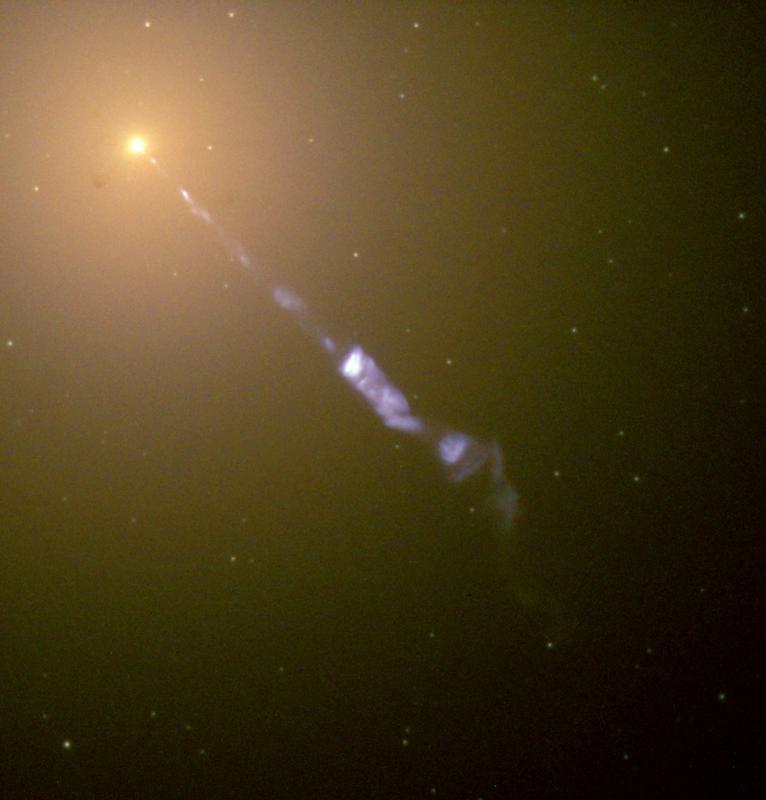







| BOOKS | F. A. Q. | ARTICLES | TALKS | ABOUT KEN | DONATE | BEYOND OUR KEN |
|---|
By Ken Croswell
Published on Scientific American (March 7, 2014)

Galaxy M87. Credit: Hubble Space Telescope. NASA and the Hubble Heritage Team (STScI/AURA).
Most of the universe is rushing away from us. It's not that we're particularly repellent; it's just that the universe is expanding, pushing most other galaxies away. Light from distant galaxies travels toward us through this expanding space, which stretches their light to longer, or redder, wavelengths. As a result, the spectra of most galaxies exhibit redshifts.
Now astronomers have accidentally discovered the greatest blueshift ever seen, in a star cluster that a giant black hole may have catapulted our way.
Over small distances gravity has reversed the universe's expansion, so modest blueshifts are common. Neither the solar system nor the Galaxy is expanding. Not even the Local Group—the collection of approximately 75 galaxies that includes the Milky Way—expands. In fact, the Local Group's largest member, the Andromeda Galaxy, is moving toward us: it has a blueshift of 300 kilometers per second.
Yet astronomers have spotted an object far beyond the Local Group's borders with a blueshift of 1,026 kilometers per second, far surpassing the previous record of 780 kilometers per second set by a star in the Andromeda Galaxy. "It's always fun to be at the extreme," says Nelson Caldwell, an astronomer at the Harvard–Smithsonian Center for Astrophysics who made not just this discovery but the earlier one as well. "That was a complete accident, too!"
Astronomers have recorded greater velocities when jets or explosions shoot debris toward us, but they've never seen the main body of any star, star cluster, or galaxy exhibit such an extreme blueshift.
Caldwell and his colleagues were measuring Doppler shifts of star clusters around M87, a giant elliptical galaxy located at the heart of the Virgo Cluster, 54 million light-years from Earth. Unlike the Local Group, which holds only two giant galaxies—Andromeda and our own Milky Way—the Virgo cluster has dozens of large galaxies. M87 possesses an enormous number of tightly packed star clusters called globulars. Whereas the Milky Way has about 160 known globular clusters, M87 boasts some 10,000. Moreover, M87's center has a black hole that dwarfs the Milky Way's, weighing 6 billion to 7 billion times more than the Sun, over a thousand times as massive as the 4-million–solar mass black hole occupying the Milky Way's center.
In 2005 astronomers reported finding a so-called hypervelocity star that the Milky Way's central black hole had kicked away. According to an idea proposed two decades earlier, when a binary star system skirts close enough to a black hole, one star falls in, losing a large amount of energy; in order to conserve energy, the other star shoots away at high speed.
A different three-body scenario may explain what Caldwell's team calls the first hypervelocity globular cluster. If M87's black hole actually consists of two black holes orbiting each other, they could fling away a star cluster that strayed too near. The cluster's gravity causes the two black holes to get a little closer together, making them lose orbital energy that gets transferred to the star cluster. If it rushes away in our direction, it can acquire a large blueshift even though the galaxy it sprung from has a redshift of 1,307 kilometers per second. The astronomers have submitted their work to The Astrophysical Journal Letters.
"It's a very interesting object," says Daniel Batcheldor, an astronomer at the Florida Institute of Technology who is not affiliated with the researchers. "We do suspect that there has been a binary black hole at the center of M87 in the past but we don't think that there's one right now." A binary black hole can arise after two large galaxies, each with their own black holes, smash together. Furthermore, such galaxy mergers would explain M87's gargantuan size. When its central black hole was still two separate supermassive black holes, it could have hurled the star cluster away. But Batcheldor says the blueshifted object may instead be a dwarf galaxy on the far side of M87 that is plunging into the galaxy, explaining its high velocity toward us.
Additional observations are vital. "To really nail down that it's been ejected from M87, we would like to know its distance," Caldwell says. The Hubble Space Telescope can glimpse the cluster's brightest stars, which will reveal how far it is. If it's closer than M87, that would favor the ejection scenario.
Despite its extreme blueshift, the object won't hit us, because it surely has some sideways motion. But it faces a lonely future. "This thing will eventually leave Virgo and then be in between clusters of galaxies," Caldwell says. "If it really was ejected by some binary black hole mechanism, then there probably should be a few more. We're certainly going to keep looking."
Ken Croswell earned his Ph.D. in astronomy from Harvard University and is the author of The Alchemy of the Heavens and The Lives of Stars.
"An engaging account of the continuing discovery of our Galaxy...wonderful." --Owen Gingerich, The New York Times Book Review. See all reviews of The Alchemy of the Heavens here.
"A stellar picture of what we know or guess about those distant lights."--Kirkus. See all reviews of The Lives of Stars here.
| BOOKS | F. A. Q. | ARTICLES | TALKS | ABOUT KEN | DONATE | BEYOND OUR KEN |
|---|